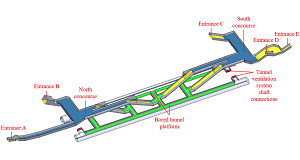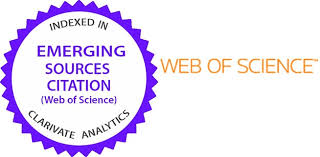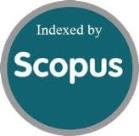Evaluation of Passenger Thermal Comfort for Two Different Underground Metro Station Typologies in Istanbul
DOI:
https://doi.org/10.46604/ijeti.2024.14795Keywords:
thermal comfort, field measurements, relative warmth index, underground metro station typologyAbstract
This study examines two different underground metro station typologies in Istanbul to evaluate passenger thermal comfort conditions. Long-term field measurements are conducted, and the relative warmth index (RWI) values are calculated to compare the stations’ thermal comfort conditions. The RWI method is employed due to transient environments in metro stations. Dry-bulb temperature and relative humidity data are simultaneously measured at 19 points in Şişli/Mecidiyeköy and 17 points in Gayrettepe station at one-minute intervals. The measurements are conducted every day throughout spring, summer, and autumn. The results show that the expected thermal comfort conditions at the stations are not met for all three seasons. Passenger thermal comfort is at its lowest level in summer, followed by autumn and spring. The RWI values for the platform and concourse levels at the cut-and-cover type are higher than at the bored-tunnel type station due to the lower train-induced air velocity in cut-and-cover type stations.
References
Y. S. Ünal, C. Y. Sonuç, S. Incecik, H. S. Topcu, D. H. Diren-Üstün, and H. P. Temizöz, “Investigating Urban Heat Island Intensity in Istanbul,” Theoretical and Applied Climatology, vol. 139, no. 1-2, pp. 175-190, 2020.
ASHRAE Handbook—Fundamentals. Atlanta, GA: American Society of Heating, Refrigerating and Air-Conditioning Engineers, 2021.
X. Ye, Z. Lian, C. Jiang, Z. Zhou, and H. Chen, “Investigation of Indoor Environmental Quality in Shanghai Metro Stations, China,” Environmental Monitoring and Assessment, vol. 167, no. 1-4, pp. 643-651, 2010.
A. Passi, S. M. S. Nagendra, and M. P. Maiya, “Characteristics of Indoor Air Quality in Underground Metro Stations: A Critical Review,” Building and Environment, vol. 198, article no. 107907, 2021.
S. T. Tan, N. Mohamed, L. C. Ng, and J. Aik, “Air Quality in Underground Metro Station Commuter Platforms in Singapore: A Cross-Sectional Analysis of Factors Influencing Commuter Exposure Levels,” Atmospheric Environment, vol. 273, article no. 118962, 2022.
C. Lin, L. Wu, H. Xia, M. Zhen, C. Shen, J. Zhu, et al., “Characteristics of the Thermal Environment, Air Quality, and Passenger Comfort in the Underground Transfer Space of Metro Stations in Beijing,” Journal of Building Engineering, vol. 59, article no. 105093, 2022.
J. Yang, X. Fan, H. Zhang, W. Zheng, and T. Ye, “A Review on Characteristics and Mitigation Strategies of Indoor Air Quality in Underground Subway Stations,” Science of the Total Environment, vol. 869, article no. 161781, 2023.
A. Passi, S. M. S. Nagendra, and M. P. Maiya, “Occupational Exposure and Personal Exposure to Hazardous Air Pollutants in Underground Metro Stations and Factors Causing Poor Indoor Air Quality,” Air Quality, Atmosphere & Health, vol. 16, no. 9, pp. 1851-1870, 2023.
Z. Wang, J. Liu, M. Yao, M. He, W. Shang, and X. Dong, “Indoor Air Quality and Sick-Building Syndrome at a Metro Station in Tianjin, China,” Environment International, vol. 187, article no. 108673, 2024.
A. S. Karim, M. Malone, A. Bruno, A. L. Eggler, M. A. Posner, and K. M. Shakya, “Assessment of Air Quality in the Philadelphia, Pennsylvania Subway,” Journal of Exposure Science & Environmental Epidemiology, in press. https://doi.org/10.1038/s41370-024-00711-9
H. R. Oh, D. S. R. Park, H. Y. Ko, J. Seo, M. Lee, and W. Choi, “Comprehensive Analysis of PM2.5 Concentrations in the Seoul Metro Underground Stations: Relationships with Indoor Sources and Outdoor Air Quality,” Asia-Pacific Journal of Atmospheric Sciences, vol. 61, no. 1, article no. 1, 2025.
G. Katavoutas, M. N. Assimakopoulos, and D. N. Asimakopoulos, “On the Determination of the Thermal Comfort Conditions of a Metropolitan City Underground Railway,” Science of the Total Environment, vol. 566-567, pp. 877-887, 2016.
F. Ampofo, G. Maidment, and J. Missenden, “Underground Railway Environment in the UK Part 1: Review of Thermal Comfort,” Applied Thermal Engineering, vol. 24, no. 5-6, pp. 611-631, 2004.
F. Ampofo, G. Maidment, and J. Missenden, “Underground Railway Environment in the UK: Part 3: Methods of Delivering Cooling,” Applied Thermal Engineering, vol. 24, no. 5-6, pp. 647-659, 2004.
Subway Environmental Design Handbook, Volume I: Principles and Applications, 2nd ed., Washington, D.C.: United States Department of Transportation, 1976.
D. H. K. Lee and A. Henschel, Evaluation of Thermal Environment in Shelters, Washington, D.C.: United States Department of Health, Education, and Welfare, Public Health Service, Division of Occupational Health, 1963.
P. O. Fanger, Thermal Comfort. Analysis and Applications in Environmental Engineering, Copenhagen: Danish Technical Press, 1970.
Ergonomics of the Thermal Environment—Analytical Determination and Interpretation of Thermal Comfort Using Calculation of the PMV and PPD Indices and Local Thermal Comfort Criteria, ISO Standard 7730, 2005.
Thermal Environmental Conditions for Human Occupancy, ASHRAE Standard 55, 2023.
P. Ordódy, “Thermal Comfort in the Passenger Areas of the Budapest Metro,” Periodica Polytechnica Mechanical Engineering, vol. 44, no. 2, pp. 309-317, 2000.
M. Abbaspour, M. J. Jafari, N. Mansouri, F. Moattar, N. Nouri, and M. Allahyari, “Thermal Comfort Evaluation in Tehran Metro Using Relative Warmth Index,” International Journal of Environmental Science and Technology, vol. 5, no. 3, pp. 297-304, 2008.
M. Marzouk and A. Abdelaty, “Monitoring Thermal Comfort in Subways Using Building Information Modeling,” Energy and Buildings, vol. 84, pp. 252-257, 2014.
J. Han, S. B. Kwon, and C. Chun, “Indoor Environment and Passengers’ Comfort in Subway Stations in Seoul,” Building and Environment, vol. 104, pp. 221-231, 2016.
M. N. Assimakopoulos and G. Katavoutas, “Thermal Comfort Conditions at the Platforms of the Athens Metro,” Procedia Engineering, vol. 180, pp. 925-931, 2017.
K. Sinha and E. Rajasekar, “Thermal Comfort Evaluation of an Underground Metro Station in New Delhi Using Agent-Based Modelling,” Building and Environment, vol. 177, article no. 106924, 2020.
S. Pan, Y. Liu, L. Xie, X. Wang, Y. Yuan, and X. Jia, “A Thermal Comfort Field Study on Subway Passengers During Air-Conditioning Season in Beijing,” Sustainable Cities and Society, vol. 61, article no. 102218, 2020.
A. Passi, S. M. S. Nagendra, and M. P. Maiya, “Evaluation of Comfort Perception of Passengers in Urban Underground Metro Stations,” Energy for Sustainable Development, vol. 68, pp. 273-288, 2022.
X. Sui, S. Chen, B. Han, and S. Yu, “Evaluation of the Thermal Environment of Xi’an Subway Stations in Summer and Determination of the Indoor Air Design Temperature for Air-Conditioning,” Sustainability, vol. 15, no. 7, article no. 6111, 2023.

Published
How to Cite
Issue
Section
License
Copyright (c) 2025 Ismail Ahmet Odabaş, Nurdil Eskin

This work is licensed under a Creative Commons Attribution-NonCommercial 4.0 International License.
Copyright Notice
Submission of a manuscript implies: that the work described has not been published before that it is not under consideration for publication elsewhere; that if and when the manuscript is accepted for publication. Authors can retain copyright in their articles with no restrictions. Also, author can post the final, peer-reviewed manuscript version (postprint) to any repository or website.

Since Jan. 01, 2019, IJETI will publish new articles with Creative Commons Attribution Non-Commercial License, under Creative Commons Attribution Non-Commercial 4.0 International (CC BY-NC 4.0) License.
The Creative Commons Attribution Non-Commercial (CC-BY-NC) License permits use, distribution and reproduction in any medium, provided the original work is properly cited and is not used for commercial purposes.







.jpg)


